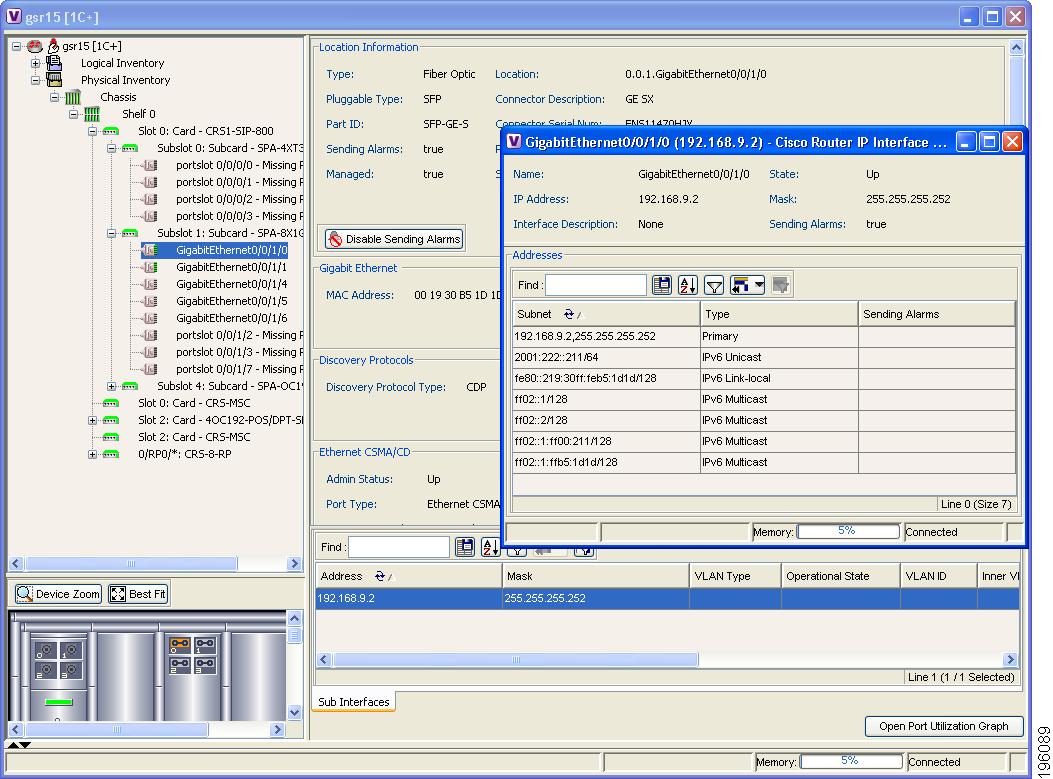

-
Cisco Active Network Abstraction User Guide, 3.7.1
-
Preface
-
Cisco ANA Client Overview
-
Working with the Cisco ANA NetworkVision Client
-
Viewing Network Element Properties
-
Working with Cisco ANA NetworkVision Maps
-
Working with Links
-
Working with Business Tags and Business Elements
-
Working with the Cisco ANA EventVision Client
-
Tracking Faults Using Cisco ANA EventVision
-
Working with Tickets in Cisco ANA NetworkVision
-
Working with Reports
-
Using Cisco ANA PathTracer to Diagnose Problems
-
Monitoring Carrier Ethernet Services
-
Monitoring Carrier-Grade NAT Properties
-
Monitoring DWDM Properties
-
Viewing Ethernet Operations, Administration, and Maintenance Tool Properties
-
IPv6 and IPv6 VPN over MPLS
-
Monitoring MPLS Services
-
Monitoring MToP Services
-
Viewing SBC Properties
-
Icon Reference
-
Index
-
Table Of Contents
User Roles Required to Work with IPv6 and 6VPE
IPv6 and IPv6 VPN over MPLS
IPv6 VPN over MPLS, also known as 6VPE, uses the existing MPLS IPv4 core infrastructure for IPv6 transport to enable IPv6 sites to communicate over an MPLS IPv4 core network using MPLS label switch paths (LSPs). 6VPE relies on MP-BGP extensions in the IPv4 network configuration on the PE router to exchange IPv6 reachability information. Edge routers are configured to be dual-stacks running both IPv4 and IPv6, and use the IPv4 mapped IPv6 address for IPv6 prefix reachability exchange.
The following topics tell you how you can use Cisco ANA to view 6PVE properties:
•
User Roles Required to Work with IPv6 and 6VPE
User Roles Required to Work with IPv6 and 6VPE
Table 16-1 identifies the roles that are required to work with IPv6 and 6VPE in Cisco ANA. Cisco ANA determines whether you are authorized to perform a task as follows:
•
For GUI-based tasks (tasks that do not affect devices), authorization is based on the default permission that is assigned to your user account.
•
For device-based tasks (tasks that do affect devices), authorization is based on the default permission that is assigned to your account. That is, whether the device is in one of your assigned scopes and whether you meet the minimum security level for that scope.
For more information on user authorization, see the Cisco Active Network Abstraction 3.7.1 Administrator Guide.
Table 16-1 Default Permission/Security Level Required for Viewing IPv6 Properties
View IPv6 properties
X
X
X
X
X
Viewing IPv6 Information
Cisco ANA NetworkVision displays IPv6 addresses when they are configured on PE and CE routers in the Cisco ANA NetworkVision IP interface table. IPv6 addresses are:
•
Displayed in the Cisco ANA NetworkVision map pane for IPv6 links.
•
Displayed in logical and physical inventory for routing and interface information, including IP, PPP, and High-Level Data Link Control (HDLC).
•
Used in Cisco ANA PathTracer to trace paths and present path trace results.
IPv6 information appears in the following locations in logical and physical inventory:
MPBGPs
IP address family identifiers indicate the BGP peer address family: IPv4, IPv6, VPNv4, or VPNv6. For information, see Viewing MP-BGP Information, page 17-30.
Routing Entities
IPv6 addresses appear under the IP Interfaces tab in the table view when applicable, and the interface properties window.
VRFs
IPv6 addresses appear under the Sites tab in the interface table and interface properties popup window, and in the VRF IPV6 Routing Table tab. See Figure 17-5 on page 17-19.
Port
IPv6 addresses appear in the Subinterfaces tab and interface properties popup window.
The IP addresses that appear depend on whether the interface has only IPv4 addresses, only IPv6 addresses, or both IPv4 and IPv6 addresses, as shown in Table 16-2.
Note
To display the properties window, right-click the IP address in the interface table and choose Properties.
Be aware of the following when working with IPv6 addresses:
•
Cisco ANA NetworkVision MPLS label switching and Label Switching Entities (LSEs) do not display IPv6 addresses. However, the Neighbor Discovery Protocol (NDP) table does display IPv6 addresses.
•
Cisco ANA supports all the textual presentations of address prefixes. However, Cisco ANA NetworkVision displays both the IP address and the subnet prefix, for example:
12AB::CD30:123:4567:89AB:CDEF, 12AB:0:0:CD30::/60
Note
Interfaces or subinterfaces that do not have IP addresses are not discovered and therefore are not shown in Cisco ANA NetworkVision.
Figure 16-1 shows a port inventory view of a port with IPv4 and IPv6 addresses. In this example, one IPv4 address and multiple IPv6 addresses are provisioned on the interface.
•
The primary IPv4 address appears in the interface table and properties window. If secondary IPv4 addresses were provisioned on the interface, they would appear in the properties window.
•
IPv6 addresses provisioned on the interface appear in the properties window and Sub Interface tab.
Figure 16-1 Port with IPv4 and IPv6 Addresses
Figure 16-2 shows a port with only IPv6 addresses provisioned. In this example, the lowest IPv6 address is shown in the subinterface table, and all IPv6 addresses are shown in the interface properties window.
Note
For information on the IPv6 addressing format, see the Cisco Active Network Abstraction 3.7.1 Theory of Operations Guide.
Figure 16-2 Port with IPv6 Addresses

 Feedback
Feedback

